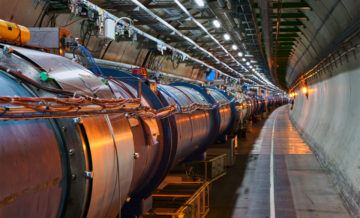Jon Butterworth in The Cosmic Shambles:
 The experiment measures the decays of B-hadrons, particles containing bottom quarks. Quarks make up the protons and neutrons inside every atomic nucleus, but those are “up” and “down” quarks. The bottom quark is one of their cousins, and is much heavier.
The experiment measures the decays of B-hadrons, particles containing bottom quarks. Quarks make up the protons and neutrons inside every atomic nucleus, but those are “up” and “down” quarks. The bottom quark is one of their cousins, and is much heavier.
This means B-hadrons need something like the collisions at the LHC to produce them (that’s the “b” in LHCb). It also means they are unstable, because the b-quark inside them will decay to less massive particles.
One type of particles that can be produced in these decays is a lepton. In this case, either an electron, or their heavier cousin, the muon. The Standard Model makes a very firm prediction that both these decays should be equally likely. The measurement shows that the decay to pairs of muons only happens about 85% as often as the decay to pairs of electrons.
Of course, the devil is in the uncertainties.
